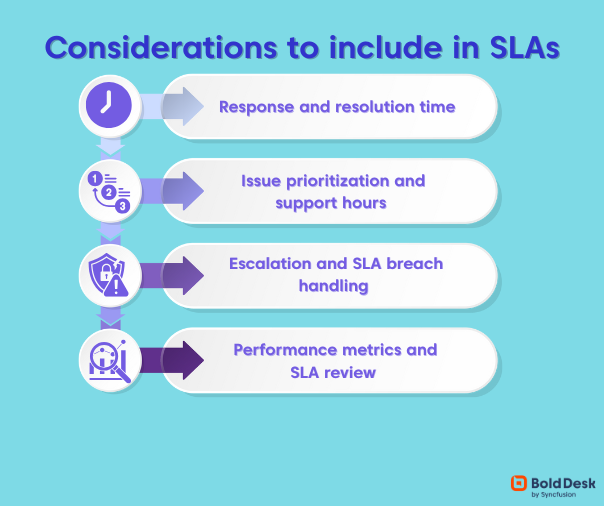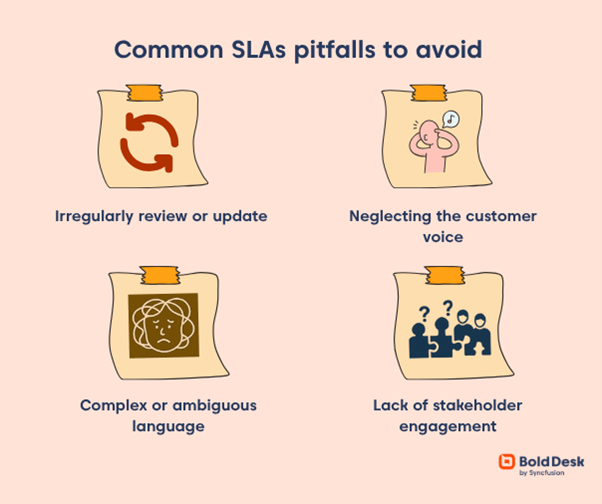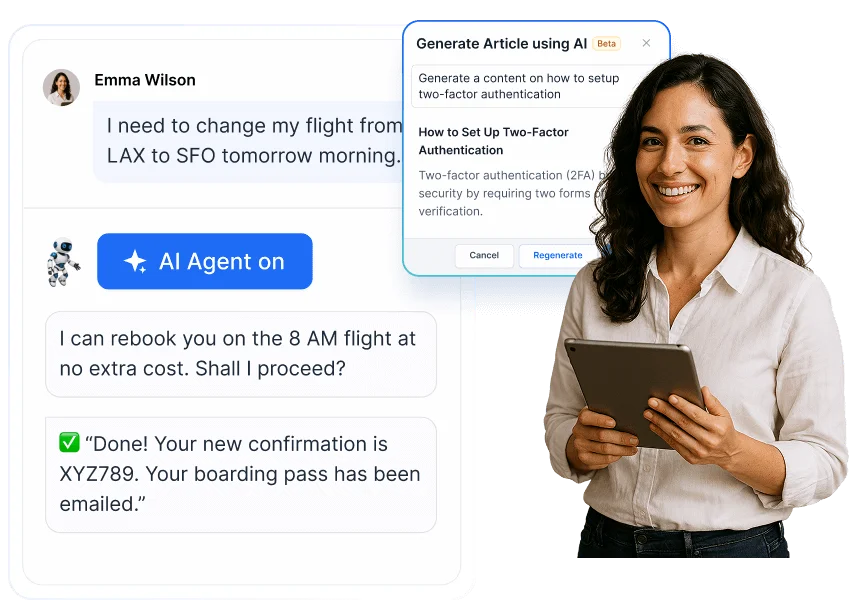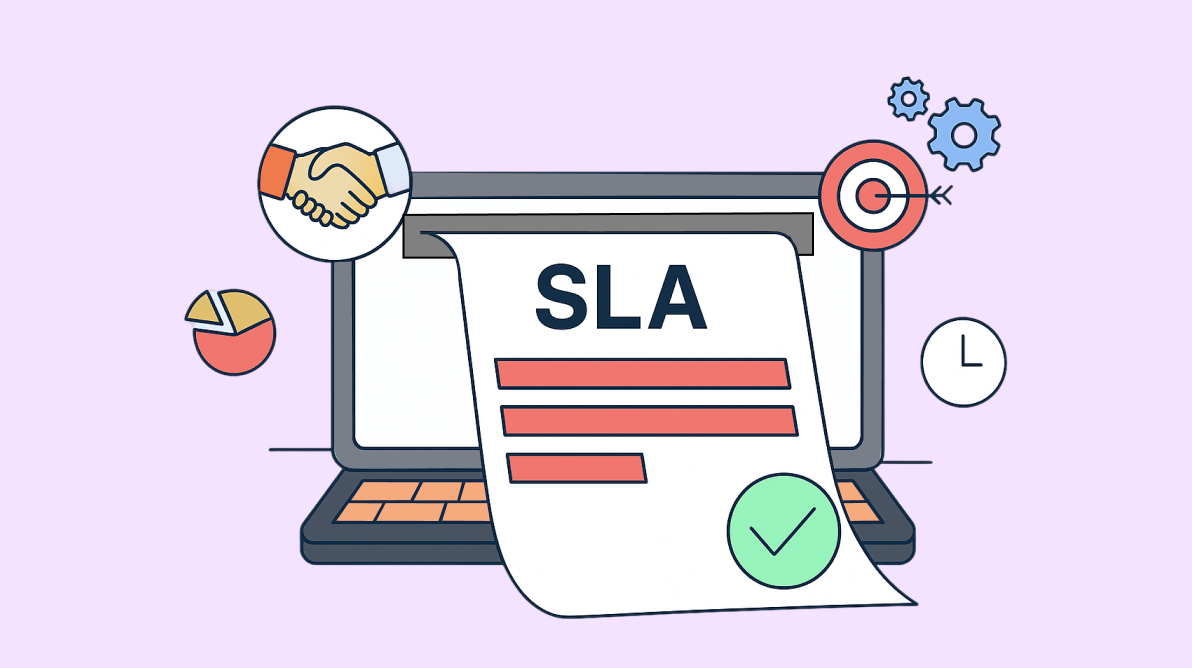Imagine reaching out to a company for support, only to be left waiting endlessly with no clear resolution in sight. Frustrating, right? Now flip the scenario; what if your business is the one providing that experience?
That’s where Service Level Agreements (SLAs) come in. More than just formal documents, these are the backbone of trust between you and your customers. You get a clear outline of what’s promised, what’s expected, and how to measure success.
In this blog, we will look at the full guide of these SLAs to help you deliver consistently excellent customer service
What is a Service-Level Agreement?
A service level agreement is a formal, documented agreement between a service provider and a client.
Generally, SLAs define the specific services to be provided, the standards of performance the client can expect, and the metrics to measure that performance.
In customer service, SLAs typically outlines the expected level of service, including:
- How quickly will a support agent respond to a customer inquiry? (e.g., within 1 hour for urgent issues)
- What is the maximum time allowed to resolve the issue?
- Specific timeframe when support is available (e.g., 24/7, business hours, holidays).
- What steps should be taken if the SLA is not met?
Clearly defining all these aspects shows a business’s genuine customer-facing commitment to deliver outstanding support to customers.
What does this mean? Businesses will always meet customers expectations and in return will win their customers’ trust in the brand or company as a whole.
Why service level agreements are crucial for modern customer service
When customers reach out with a problem, they want to know: “Will someone help me—and when?” That’s where Service Level Agreements (SLAs) come in.
SLAs aren’t just internal metrics. They’re promises with clear, measurable commitments that define how quickly your support team will respond to and resolve customer issues. When used effectively, they can transform your customer support experience.

Sets clear expectations
A well-defined SLA sets clear and precise targets that tell customers exactly what to expect, building their confidence while leaving no room for guesswork and confusion.
It replaces vague promises like “we offer fast support” with transparent, measurable commitments like “we will respond to all urgent requests within one hour.”
Improves agent productivity
SLA gives support teams have a clear structure to their workflow process for managing their workload. This ensures they prioritize tickets more efficiently, based urgency (e.g., Urgent, High, Normal), and impact, improving team productivity.
Helps make smarter, data-driven decisions
The SLA metrics are a goldmine of data, that highlight where your support process is thriving and where it’s falling short. Managers can use these insights to optimize their workflows and allocate resources wisely to consistently improving service quality.
Builds customer trust and loyalty
These service level documents are a two-way street. They hold the service provider accountable for performance and outline the customer’s responsibilities (e.g., providing necessary information).
Meeting (or exceeding) SLAs consistently shows customers that you respect their time and take their concerns seriously. That’s how customer loyalty is earned.
What are the key considerations for creating an effective SLA?
Creating a well-defined and effective Service Level Agreement (SLA) is essential for delivering consistent and high-quality customer support. A strong SLA sets clear expectations, improves accountability, and enhances customer satisfaction. Here are the key elements to include in your customer service SLA:

- Response and resolution times – Specify the time it takes for support to respond to and resolve customer issues, based on their urgency.
- Ticket prioritization – Categorize issues by urgency and impact, from critical to low, with defined response time targets.
- Support availability hours – Specify the timeline when your support team is available to assist customers. This can include 24/7 support, business hours (e.g., 9 AM – 5 PM), or hybrid models. Make it clear whether support is available online, offline, or both.
- Escalation and breach handling – Outline the steps for escalating unresolved issues and define the process for handling SLA breaches. Include consequences, solutions and compensations for if agreement terms are not met.
- Performance standards – Measures performance metrics and KPIs such as First Response Time, First Contact Resolution, SLA Compliance Rate, and CSAT Score, to assess service quality. Also outline how often SLAs are reviewed and updated.
Types of customer service level agreements
Service level agreements can be structured in different ways depending on your business model. The main types of SLA include:

- Customer-based: This is a type of SLA for a single customer or group that covers all the services they use. It is common for large enterprise clients with custom needs.
- Service-based: This type of service level agreement defines a uniform service standard applicable to all customers utilizing a specific service.
For instance, a telecommunications provider may commit to delivering a consistent internet bandwidth to all users subscribed to a particular plan. - Multilevel: This SLA uses a hybrid approach that combines elements for different customer sets. It might include a corporate-level component that applies to all users, along with specific agreements for different customer tiers (e.g., Basic, Premium, Enterprise).
- Internal: Refers to a formal agreement between departments that defines how they’ll work together and their specific roles to support the expected customer commitments.
For example: If customer service promises 24-hour bug resolution, engineering may commit to responding within 4 hours. Without this internal support, the external service level agreement may not hold.
9 SLA best practices for smoother support and happier customers
Once you understand the importance of a Service Level Agreement, the next step is to focus on implementing it effectively.
To avoid the risks of overpromising and under-delivering, consider these ten SLA strategies that drive customer satisfaction and enhance team performance.
Set realistic, data-driven SLA targets
SLA targets that look good on paper but don’t work in practice can lead to frustration. Instead, base your SLA goals on real performance data. This helps your team stay consistent and builds trust by setting expectations you can actually meet.
How to set realistic SLA goals:
- Export historical data: Retrieve and analyze past ticket data from your customer service software to know your current status and identify trends in your key metrics.
- Know your objectives: Clearly define what your SLA goals are intended to accomplish—whether it’s improving customer satisfaction, reducing resolution time, or increasing operational efficiency. Your objectives should guide every aspect of SLA design.
- Decide on the right SLA conditions: Choose SLA condition fields that reflect your service structure and priorities. The common SLA condition fields include: brand, contact & contact Group, category, type, assigned group, etc.
- Team capacity: Consider your team’s current capacity and ticket volumes.
- SMART goals: Create and align your SLA goals with customer expectations and business priorities.
Pro-tip: Start with achievable goals and refine them as your team grows more efficient.
Involve all your support teams
Even the best SLA strategy can fail if your support team doesn’t understand it. Involving them in the process makes the agreements terms actionable and more authentic with respect to customer priorities.
Additionally, customer-facing teams will prioritize objectives that hold real-time significance while maintaining a healthy work-life balance throughout the process.
How to get your team involved:
- Agent SLA awareness: Engage support agents while designing the SLA. Ensure you communicate SLA terms clearly to agents so they know how SLAs work, how they’re measured, and what happens when they’re breached.
- Ask for feedback: Agents understand the clients’ needs and expectations so well because they are the first point of contact for clients. Therefore, request for their input and utilize their insights to determine and sensitize the service level standards.
- Support team SLA education: Provide SLA training during onboarding and regular refreshers to keep everyone aligned with the SLA goals and accountable. Additionally, provide documentation and cheat sheets for quick reference.
Automate your SLA workflows
When deadlines are tight, automation is your best ally to ensure that SLA targets are consistently met. SLA automation allows support teams to offer proactive customer service, improve team productivity, and minimizes ticket forgetfulness.
How to automate workflows:
- Create workflow rules: Set up detailed SLA automation rules in your customer support application to automatically assign the right SLA policy to each ticket.
- Reminders, notifications and alerts: Use automation to trigger SLA alerts and notify agents when tickets are nearing SLA breaches, such as when response or resolution due is approaching, to keep the issue from being ignored.
- Set up escalation paths: Create a clear SLA escalation rules for when a ticket breach occurs. For instance, you can set an SLA escalation rule to alert a manager or respective agent of overdue tickets. This ensures they give the issue immediate attention or move to a more experience agent to handle it.
SLA example: If a high-priority ticket is not resolved within 4 hours, escalate it to a senior agent automatically.
Outline your procedure for SLA breaches
Things sometimes inevitably go wrong while offering customer service, like an outage, a website crash, or unexpected server maintenance, causing delays in delivering support on time.
With customers being 2.4 times likely to stay with a company if their issues are resolved fast, an effective escalation management plan can save the day.
If your SLA escalation process is clearly defined, your team can respond to or resolve unforeseen issues efficiently with minimal disruptions, to quickly restore the customer trust and confidence in your brand.

How to handle SLA breaches effectively:
- Set out a clear SLA escalation process: First, define what qualifies as a breach (e.g., missed response or resolution time). Then, determine what steps to take in case resolution misses an SLA target such as escalating the ticket issue, informing the customer, or offering a goodwill small credit.
- Empower the team: Enable support agents to take the SLA breach measures according to the SLA breach process independently, with minimal approvals. Designate who will be handling SLA violations follow-ups, whether it’s an agent, team lead, manager, or escalation specialist.
- Automate SLA alerts: Use your help desk software to notify agents and escalate overdue tickets.
- Create and send SLA breach responses: Create prewritten and empathetic customer service email templates so that your team can quickly send SLA incident responses. Additionally, communicate with affected customers through timely updates explaining the delay and outlining next steps.
Customize SLAs to fit different needs
Generally, an SLA can hardly be termed as a cut-and-paste agreement; for one reason, a single agreement cannot apply to all given situations.
The agreements should vary because the issues are not the same, and different clients or brands might have their own unique requests.
How to customize multiple SLAs:
- Implement tiered SLA structures – Set up customizable SLA policies based on issue type, ticket prioritization (e.g., Critical, High, Normal, Low), type of customer or available channels, to ensure all issues are addressed efficiently.
- Create brand-specific SLAs – If your support team manages more than one brand, it’s important to create separate SLAs for each to reflect their unique workflows, expectations, and service commitments.

This method ensures each issue is handled on an SLA by get prioritized and dealt with first by the team.
Define your team’s roles and responsibilities
Prioritizing organizational readiness isn’t just smart—it’s strategic. A 2025 Gartner survey found that customer service leaders who focused on organizational readiness (rather than just technology selection) saw a 300% increase in the likelihood of meeting customer expectations.
Readiness to SLA includes well-defined responsibilities for support agents, other internal customer-facing teams, and even the customer.
When involved party knows the specific roles they play, unnecessary delays reduce significantly and it helps avoid assigning blame when an issue occurs, whether internal or external.
How to define the roles:
- Internal team roles: Clearly outline the expectations of your support team and other departments in service delivery. This ensures smooth collaboration and internal alignment.
- Access roles and permissions – Specify who has access to systems, tools, and data relevant to service operations. Assign permissions based on roles to control who can view, modify, or manage sensitive information, ensuring security and operational integrity.
- Decision-making authority – Identify who is responsible for making key decisions, such as handling escalations, approving changes, or resolving conflicts. Clear decision ownership helps streamline processes and ensures timely action.
Communicate your support availability clearly
If your SLA communication on your help desk schedule or operating customer service hours aren’t clearly stated, users might merely assume your team to be available 24/7.
Prevent this misunderstanding through SLA policy transparency on whether you offer 24/7 customer service or operate your support on specific business hours.
How to communicate your availability:
- Display support hours: Clearly expose your customer service hours and help desk schedule on your Contact Us page, website, help center pages, FAQs and live chat software. Also, update availability during holidays or special events to avoid confusion.
- Alternative options: In case you are unavailable, consider including any alternative contact information or channels you have. You can also inform them when you will be next available so they can contact you again.
- Share in messages: Include availability in auto-replies and ticket confirmation emails. Reassure them that, even if they do not get an immediate response, their inquiry has reached the right level.
- Show available agents: Use live chat widgets, icons or banners to show live agent availability in real time.
- Define time zones: Clarify the availability for each time zone if you serve customers across regions.
Track the right SLA metrics
To truly honor service commitments, it’s essential to monitor the right data. Move beyond basic customer service metrics and focus on help desk KPIs that accurately reflect support quality and operational efficiency.
By tracking meaningful metrics, you gain clear insights to evaluate performance, guide hiring or tool investments, and identify areas where your team may need additional support or training.
What are key SLA performance tracking metrics?
- Response time: Refers to the time it takes for an agent to respond to new and existing tickets such as First Response Time and Time to Next Response.
- SLA achieved rate: Also known as SLA compliance rate. It is the percentage of tickets resolved within SLA targets.
- Resolution time: How long it takes to resolve an issue. This can include metrics First Contact Resolution or Total Time to Resolution.
- SLA breached rates: Percentage or number of tickets that missed SLA target deadlines.

Regularly review and adjust your SLAs
Business needs, support team capacity and customer expectations are not static, they keep changing over time.
Therefore, you should consider your SLAs as living documents and optimize it to adapt accordingly through regularly review and updates. Having updated SLAs help you stay competitive, responsive, and customer-focused.
How to do SLA optimization:
- Schedule regular SLA reviews: Have a timeline to revisit your SLAs formally and review each policy. Check the perfomance to note the achievement and SLA breach rates. This can be done quarterly, bi-annually or at least once a year depending on your preference.
- Seasonal SLA improvement: Make any necessary changes to the service levels to fit different seasons, ticket volumes, team capacity and varying levels of expectation from different customers.
- Keep updating SLA policies: During your SLA reviews, drop any outdated policies and introduce new ones as needed.
Common SLA challenges to avoid (and How to Avoid Them)
Service Level Agreements (SLAs) are essential for setting clear expectations between support teams and customers. However, many organizations fall into common traps that reduce the effectiveness of their SLAs. Here are four frequent SLA mistakes and how to fix them.

The “Set It and Forget It” mindset
Mistake: Many teams create SLAs once and never revisit them, even as business needs and customer expectations evolve.
Solution: Treat your SLA as a living document. Regularly review and update it to reflect current support goals, team capacity, and customer needs. This ensures your SLA stays relevant and achievable.
Overly complex or confusing language
Mistake: Overly technical or legal language can make SLAs hard to understand, for both customers and internal teams.
Solution: Write your SLA in clear, simple language. Avoid jargon and focus on making expectations easy to understand and follow. A well-written SLA improves transparency and accountability.
Ignoring the customer preferences
Mistake: SLAs that focus only on internal metrics (like first response time) may overlook what customers actually value—such as resolution time or communication quality.
Solution: Gather customer feedback and align your SLA metrics with their priorities. This helps build trust and ensures your service goals match customer expectations.
Lack of stakeholder involvement
Mistake: When support agents, managers, or other teams aren’t involved in SLA planning, they may feel disconnected from the goals.
Solution: Involve all relevant stakeholders in the SLA creation and review process. When everyone understands and supports the agreement, it’s easier to meet targets and improve service delivery.
Ready to level up your SLA strategy for quality support?
A Service Level Agreement is your promise to deliver excellent, reliable service. It turns vague goals into clear commitments that build customer trust.
By following the SLA strategies in this guide like setting realistic targets, involving your team, and reviewing regularly, you ensure your promises are kept, improve team performance and also earn lasting customer loyalty.
With BoldDesk, your customer-facing teams can easily and efficiently create or customize their SLA policies and metrics for outstanding support efficiency, delivering on your every promise.
Feeling motivated to take a fresh look at how your SLAs are structured? Let us know what sparked your interest, please share your thoughts in the comments!
Related articles
- 6 Reasons You Need an SLA for Customer Service
- What is an SLA? How Does an SLA Improve Productivity?
FAQs on Service Level Agreements (SLAs)
Using help desk software that supports SLA tracking, automated alerts, and reporting dashboards helps monitor compliance in real time.
- SLA: Business agreement with the customer.
- OLA (Operational Level Agreement): Internal agreement between departments.
- UC (Underpinning Contract): Business agreement with other external vendors.
Yes. Many platforms support multi-tier SLA policies, allowing you to set different targets for VIP customers, enterprise clients, or specific product lines.
If an SLA is breached, it means the service didn’t meet the agreed standard. This can lead to internal escalations, performance reviews, or even penalties, depending on the agreement.
To handle a breach effectively:
- The issue is logged and reviewed to find out why it happened.
- It is then escalated to the appropriate team to take steps to fix the problem.
- If needed, the support team adjusts the SLA targets or internal processes to prevent future breaches.



















 Email Ticketing System
Email Ticketing System Shared Inbox Software
Shared Inbox Software Multi Brand Help Desk
Multi Brand Help Desk Internal Help Desk Software
Internal Help Desk Software Trouble Ticketing Software
Trouble Ticketing Software Mobile Help Desk
Mobile Help Desk 














